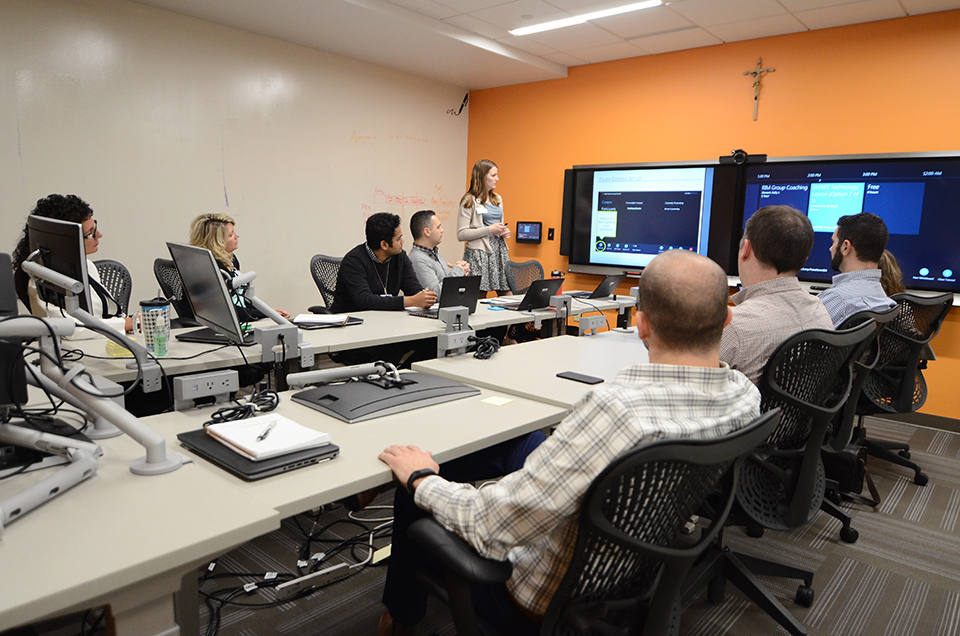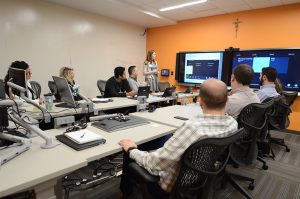
Is Continuous Improvement Innovation?
Innovation may appear to be the newest topic for health care, but at OSF HealthCare, innovation has been grounded in our Mission to serve persons in the spirit of Christ, from the very beginning. Our Sisters modeled innovation for us, from their utilization of a Peoria Journal Star newspaper helicopter for the first “Life-Flight” of a patient to the improvisation of Mission Partners in Escanaba warming a neonate by utilizing steam heat as an incubator.
 Have you ever had an idea to improve something in your workplace, but didn’t know how to turn that idea into value for others? At OSF HealthCare, we enable our Mission Partners to be “continuous innovators” by giving them the tools they need to bring about change for the betterment of our organization and the people we serve.
Have you ever had an idea to improve something in your workplace, but didn’t know how to turn that idea into value for others? At OSF HealthCare, we enable our Mission Partners to be “continuous innovators” by giving them the tools they need to bring about change for the betterment of our organization and the people we serve.
While innovation can be defined in many different ways, we at OSF define innovation as “The process of translating ideas that align with our vision of transforming health care into value for the benefit of the patients and communities we serve.” Building a culture of innovation is about instilling a desire to create fundamental change which is becoming increasingly important as we navigate tremendous change in healthcare.
Our Performance Improvement Division, a part of OSF Innovation, leads efforts to nurture concepts that will improve existing products, processes or services. These are ideas we believe will eliminate unnecessary waste and ultimately improve the quality of care.
We refer to this work as core innovation and it’s the bedrock of our vision to transform health care. Our competency in Performance Improvement is an integral part of building the culture of innovation at OSF.
Rapid Improvement Model
OSF Performance Improvement offers Rapid Improvement Model (RIM) training to support the pursuit of continuously improving the organization. RIM projects are strategically selected work initiatives that are capable of being accomplished in a 90-day time frame.
Value of RIM Training:
- Builds improvement into culture as a core competency
- Enables breakthrough performance and efficiency in targeted areas
- Enables operational improvement in department/division metrics
- Fosters development of leadership competency in performance improvement
Training is offered annually three times a year. Each training session is three days. Content Includes:
- Leading teams
- Communicating with Mission Partners
- Identifying focused problems
- Evaluating and implementing the right solutions
- Sustaining the change
Tools and Methodologies include:
- Change Management (mitigating resistance)
- Project Management (managing project work to a timeline)
- Lean
- Eliminating waste as defined by those we serve by evaluating value and non-value added steps of our processes. This includes evaluating the layout of the work and identifying the standard work processes to ensure consistent value to those we serve.
Employing the RIM to Improve Care: Streamlining the Pre-Operative Testing Process
OSF Saint Anthony’s Health Center identified that in its current state, patients coming for pre-operative testing had to walk to several areas of the hospital to complete the testing and wait at each step. After an analysis of the initial data, it was determined that the duration of a patient’s appointment actually took 45 minutes, but their current average time at the Medical Center was 2 hours.
Patients were expressing displeasure in the process as tracked by Cardiology Mission Partners. With patient satisfaction as one of our Key Results, they identified an opportunity to impact their scores by streamlining the pre-op testing process and improving the patient experience. Sarah, the Performance Improvement Lead identified through walking this process, it was taking patients 135 minutes and 675 number of steps to complete their pre-operative testing. She and her Team of Mission Partners involved in the process were able to reduce the time it takes to do pre-operative testing to 35 minutes and 346 number of steps!
Achieving Continuous Improvement in 90-days
FOCUS PDCA is:
- Find an opportunity to improve determined by variation in data collection on key indicators, measures or outcomes
- Organize a team that is directly involved in and understands the process
- Clarify team needs to understand the current process so they can analyze it and differentiate the way it actually works and the way it was meant to work
- Understand the cause of process variation
- Select the most appropriate solution keeping in mind cost and degree of difficulty to implement
- Plan by outlining and documenting improvements to be tested
- Do the small tests of change
- Check the results of the small test of change (re-work as needed)
- Act by analyzing improvements made, determining where to apply changes and ensuring continuous monitoring to sustain improvement
- Utilizing small tests of change we can identify “quick fixes” to accelerate improvements. With incremental and continuous process improvements, it allows us to define and validate the improvement opportunity we have identified.
Improving Quality of Life for Oncology Patients
OSF Saint Anthony Medical Center identified that palliative care services were only offered to inpatients. Many clinical trials have demonstrated the multitude of benefits that palliative care services can provide for oncology patients, including better symptom management, less depression and anxiety, better communication with care teams, better advance care planning and better quality of life. It can also help ensure that patients are aware of and appropriately referred to hospice care if/when needed. An opportunity was identified to improve the care of Center for Cancer Care (CFCC) patients by providing palliative care in the outpatient oncology setting.
Peggy, the Performance Improvement Lead worked with a team of Mission Partners and developed an implementation plan to ensure patients with breast cancer, head and neck cancer, lung cancer, pancreatic or colon cancer being treated with chemotherapy will be assessed weekly using the ESAS scale tool (a tool used to measure the severity of nine of the most common symptoms of cancer patients on a scale of one to ten)).
The results will be tabulated by the oncology nurse navigators who will report any symptoms over a seven to the attending oncologist. Referral to palliative care will be initiated if the symptoms cannot be resolved by the oncologist. The initial target was 50% of patients meeting the criteria are referred to palliative care and the actual results for Fiscal Year 16 – 1st Quarter 2017 went beyond that target!
Continuous Improvement Leads to Real Change
Is OSF HealthCare including continuous improvement in our culture of innovation? Most certainly we are by following in the footsteps of our founding Sisters and continuing to improve upon what we’re doing today. Innovation requires courage, competency and culture. Continuous improvement builds the competency to support the culture to lead with courage.
If you are interested in seeing this culture of innovation at work, I invite you to visit our website to learn more about all the ways we are investing in our communities.